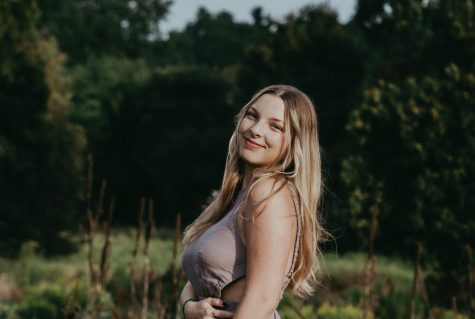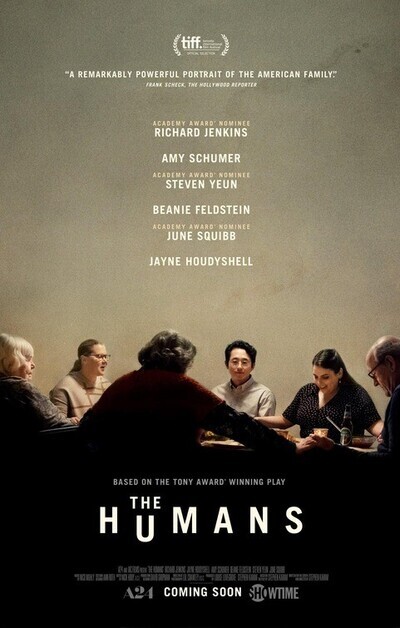The Humans is an eerie rendering of family drama through a lens of symbolism

More stories from Meghan Kennedy
Pictured here is the entire family sitting at the dinner table in the poster for The Humans.
When one thinks of Thanksgiving, the word “frightening” does not typically come to mind. But underneath the abundantly decorated dining table and the expressions of gratitude, tensions in family matters can have the tendency to fester; these issues can turn a traditional dinner into a minefield of discomfort. Personifying this ever-so common problem among people and families is the movie The Humans. With a twist of a more psychologically agonizing plotline, this movie perfects the recipe for a disturbing aftertaste.
The Humans was released on Nov. 24th, 2021, by the company A24, which is well known for its cinematic works. Stephen Karam—the writer and director—adapted this movie from his play also titled The Humans. Taking the form of a psychological horror and drama film, this movie resembles a deeper meaning of what it is to be a human and the horrors that are bound to it. It is a conglomeration of symbolism and cinematography showing how fractures within interpersonal relationships and the trajectory of social events embody the darker side of being human.
Though I never found myself plunged in terror in the midst of watching, this movie unearthed a profound sense of discomfort in my bones. Taking place in a dingy apartment in Chinatown, New York City, couple Brigid (Beanie Feldstein) and Richard (Steven Yeun) had recently moved into their new space and invited her family over for Thanksgiving. Brigid’s hyper Catholic parents, Deirdre (Jayne Houdyshell) and Erik (Richard Jenkins), come with catatonic grandma Momo (June Squibb) and have trekked from Scranton, Pennsylvania. Brigid’s sister, Aimee (Amy Schumer), made her way in from Philadelphia. As the whole group convenes in the empty shell of an apartment, their ghastly Thanksgiving celebration commences.
As the family reconciles, the peculiar happenings start to creep through the walls and floors of the building. On multiple occasions, loud banging from the floor above booms through Brigid and Richard’s living quarters. Coupling this sporadic collection of crashes is the aggressive sounds made by the antiquated systems of the building. Brigid and Richard are unfazed by these startling reverberations, but the dad, Erik, always seems to linger on the enigmatic fear produced by these disembodied sounds.
In fact, Erik continually examines the external pipes running across the ceiling and the paint lopped over ambiguous bumps on the walls. Although light is never shone on the meaning of his intense, fearful observations of the apartment’s skeleton, it bolsters a concrete way to show how he is enveloped in existential dread. Towards the beginning of the movie, Erik describes a nightmare that he had to the group, and the gruesome details of that dream create a motif of his inescapable unease imprinted in the architecture and the film in general.
Continuing the themes of unease is the constant tensity betwixt the family. They bicker and prod at each other’s insecurities until a breaking point is reached. In this, their archetypes are exposed, adding depth to how these interactions infect the overarching plot and the coinciding events. But past simply how the characters communicate with each other, the entire format of the movie takes place in the mold of regular, familial conversation.
From the start of the movie, I was in awe of how naturally the actors conversed with one another and how authentic it seemed; not one structural element of the script seemed dramatized or like it was following a formula but instead embraced how an organic conversation among people usually flows. I found the dialogue to be comparable to conversations that I’ve had with my own family, whether it be a mundane topic or an emotive argument. They weren’t just actors on a set mimicking a script, but rather a gathering of regular individuals blending into the universal nature of being people.
As these conversational situations pan out, the characters are captured through a distant lens, cornered by archways, walls, and other objects in the foreground of the camera. During moments when either Brigid is on a rampage or Momo is speaking gibberish, the camera never seems to focus on an individual face of any character. The cinematography allows for the viewer to inspect the family as a whole unit rather than centering on their individual issues and emotions. The point is to see how the dynamic of a family allows them to mesh as humans instead of studying how each character is enveloped in their own world of emotion.
I dove into this movie having a loose idea of what was to happen, but in reality, every unsettling event that occurred was forged by the human mind, hence the title The Humans—I was far off from my initial impression. The title boils down the complex qualities of a person to the label of “human” to demonstrate the dichotomy between action and emotion, creating a thinly-veiled layer of horror within the reality of its truth. In one scene, this concept of humans being the real monsters is exposed at the dining table amidst a conversation, shuffling in a full circle theme—it made the movie that much more surreal by the realization that is made in regards to the title.
Just because there is no gore or jumpscares mixed into the slots that would seemingly call for it, the opacity of disturbance is not quite reduced in the movie. Every movement, every frame, and every word spoken bleeds into the next, making for a plot of dynamic slow burn. Additionally, the setting never wavers from the duplex and the characters are confined to this claustrophobic space, adding in the dimension of an ongoing lucid nightmare. Because The Humans takes place on Thanksgiving, the disputes made possible by the characters contrast the harmonious meaning of the holiday, showing how human nature plays with the duality of thought and action and its effects on others.
As every thoughtfully crafted detail and frame of The Humans movie glided across the screen, viewing the needles of the plot sew these artful pieces of symbolism together made for an undoubtedly interesting watch. There is not a moment of stagnancy as every moment and angle is deeply intentional. After watching the story shatter into its final moments, I honed in new insight into the meaning of being human and the circumstances that alter the experience of being as such.

Meghan. also known as Meggie, is living up her senior year on The Central Trend. Starting out with a new role as Podcast Manager, Meggie is looking forward...



























































































